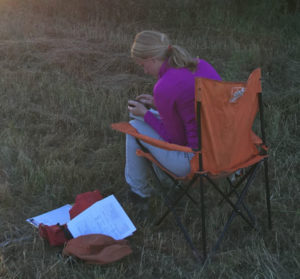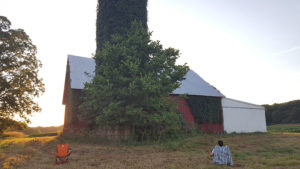In addition to mist netting and acoustic surveys of Illinois’ bats, the Illinois Bat Conservation Program is conducting roost surveys to better understand bat populations in Illinois. Bats utilize both day and night roosts and what they will use as their resting area ranges widely from single bats nestled into the loose bark of trees to thousands of bats in a large barn. Roost selection will differ as well for a bat’s day and night roost. During the day they have to find a structure with a comfortable temperature that is also relatively safe from disturbance for sleeping. At a night roost, a bat is simply resting between foraging trips so a roost of lower quality near foraging areas is generally sufficient.
One method to conduct a roost survey is to do an emergence count. This involves sitting away from the roost at an angle so that observers can spot exiting bats as they are silhouetted against the setting sun. The survey time begins a half an hour before sunset so the bats are not disturbed, which might disrupt the normal emergence pattern. After sitting silently and counting the bats until an hour after sunset, we tally up the number of bats counted which serves as an estimate of the number of bats utilizing the roost. Like all approaches, this is an imperfect survey method, but we do our best to avoid double counting by taking note of any bats re-entering the structure and having multiple independent observers. A key component to any survey method is to take detailed notes so that the method used at the site can be repeated and any atypical or interesting factors or events are documented. For example, we may not have the best angle to count every single bat in the roost, but if someone repeats the study from the same position, they should get a similar count if the population has not changed.
Roost counts are a crucial part of monitoring bat populations because we are able to repeat the same survey year after year and can observe any fluctuations in roost population size. These surveys also help to identify roosts most suited for conservation actions. For example, there may be an endangered species using the roost, or there may be an unusually large number of bats using the roost. Bats will typically select a roost structure based on their needs for space, temperature, and other factors. For example, female little brown bats (Myotis lucifugus) form large maternity colonies (sometimes in the thousands!) in the summer months within structures with a specific range of temperature that is crucial for the development of the young pups. It is important to protect these roosts because it may be difficult for them to find a substitute if access to the roost is removed.

A bat research sets up with data sheets, counter, and a great view of the sky and the roost. Staying quite and keep a good distance from the roost allows us to get count estimates of roost size.
During one of our recent surveys, we deployed an acoustic recorder at the same time that we conducted our roost count. While we can speculate on the species of bats we see using the roost-based visual observations, acoustic data can more accurately identify species based on their calls. We were lucky that the bats emerged and immediately foraged near the recorder, allowing us to identify the species as big brown bats (Eptesicus fuscus) and verify our count (time stamps on acoustic files were well-correlated with recorded times of emergence).

Folding chairs in place just before sunset, ready to count bats emerging from a barn. Note the chairs are positioned such that the bats will be silhouetted against the night sky.
In the future, we hope to make it possible for interested Illinois citizens to contribute to our roost count surveys—we will keep you posted or you can email us for more information!

